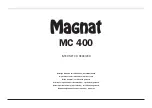
3
rd
Generation Compact RDMS
TM
Telemetry Receiver
92
Quasonix, Inc.
Figure 20: Trellis Detection Gain with Significant to Severe Phase Noise
13.2 Phase Noise Impact
Trellis demodulation is based on the assumption that the signal is following a predictable path through the trellis. If
this is not true (due to high phase noise), then a trellis demodulator cannot provide the expected performance gain.
•
Many legacy analog transmitters (a simple modulated VCO) have high phase noise.
•
Vibration often further increases phase noise.
•
Phase noise is generally more damaging at low bit rates.
•
Phase Noise Compensation (PNC) gives back some of the trellis detection gain, by shortening the trellis
observation span.
13.3 Clock Jitter Impact
Many older PCM encoders are susceptible to large inaccuracies in clock rate or have clock stability issues,
especially under harsh vibration conditions. While the RDMS is capable of tracking static clock rate errors as large
as 1000 ppM, excessive jitter causes the integrated bit sync to lose lock. Enabling the PNC mode opens the tracking
loop bandwidth to accommodate for these issues. This increase in bandwidth does have a tradeoff. A wider tracking
range allows the RDMS to deal with the additional jitter, but it may also increase synchronization times slightly, and
slightly increase the minimum SNR at which the RDMS declares lock.
13.4 When to Use PNC
There is no bullet-proof test for whether PNC is needed, but there are good indicators. Turn on PNC if:
•
The demodulator is struggling to lock, even with good Signal to Noise Ratio (SNR). ("Good" SNR means
the Quality bar is above one-quarter height.)
•
The eye pattern NEVER looks “clean,” as in Figure 21
•
Symptoms get worse when the transmitter is under vibration
•
Symptoms get worse at low bit rates











































